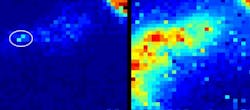Single-photon camera tracks location of endoscope deep within the body
Until now, it has not been possible to track where an endoscope is located in the body in order to guide it to the right place without using X-rays or other expensive methods. Light from the endoscope can pass through the body, but it usually scatters or bounces off tissues and organs rather than traveling straight through. This makes it nearly impossible to get a clear picture of where the endoscope is. But a new camera technology being developed as part of the Proteus Interdisciplinary Research Collaboration is developing a range of revolutionary new technologies for diagnosing and treating lung diseases.
RELATED ARTICLE: Single-photon 3D imaging reaches 10 km range
Proteus is a collaboration between the Universities of Edinburgh (Scotland) and Bath (England), and Heriot-Watt University (Edinburgh, Scotland). It is funded by the Engineering and Physical Sciences Research Council. The new camera takes advantage of advanced technology that can detect individual particles of light, called photons. Experts have integrated thousands of single photon detectors onto a silicon chip, similar to that found in a digital camera.
The technology is so sensitive that it can detect the tiny traces of light that pass through the body's tissue from the light of the endoscope. It can also record the time taken for light to pass through the body, allowing the device to also detect the scattered light. By taking into account both the scattered light and the light that travels straight to the camera, the device is able to work out exactly where the endoscope is located in the body.
Researchers have developed the new camera so that it can be used at the patient’s bedside. Early tests have demonstrated that the prototype device can track the location of a point light source through 20 cm of tissue under normal light conditions.
The research is published in the journal Biomedical Optics Express.
SOURCE: University of Edinburgh; http://www.ed.ac.uk/news/2017/medical-camera-sees-through-the-body

Gail Overton | Senior Editor (2004-2020)
Gail has more than 30 years of engineering, marketing, product management, and editorial experience in the photonics and optical communications industry. Before joining the staff at Laser Focus World in 2004, she held many product management and product marketing roles in the fiber-optics industry, most notably at Hughes (El Segundo, CA), GTE Labs (Waltham, MA), Corning (Corning, NY), Photon Kinetics (Beaverton, OR), and Newport Corporation (Irvine, CA). During her marketing career, Gail published articles in WDM Solutions and Sensors magazine and traveled internationally to conduct product and sales training. Gail received her BS degree in physics, with an emphasis in optics, from San Diego State University in San Diego, CA in May 1986.
